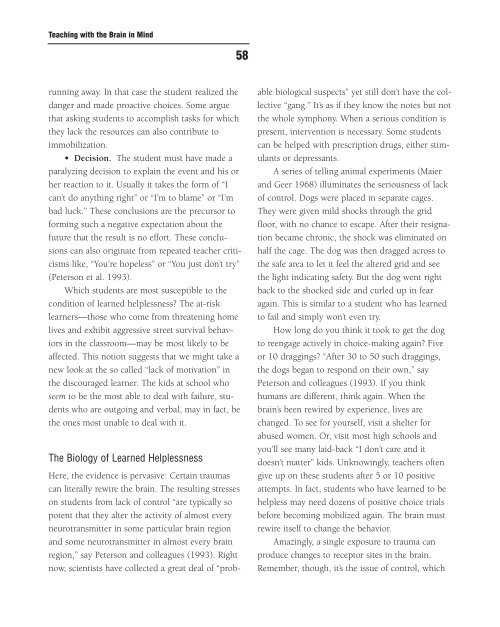Create successful ePaper yourself
Turn your PDF publications into a flip-book with our unique Google optimized e-Paper software.
<strong>Teach<strong>in</strong>g</strong> with <strong>the</strong> <strong>Bra<strong>in</strong></strong> <strong>in</strong> M<strong>in</strong>d<br />
runn<strong>in</strong>g away. In that case <strong>the</strong> student realized <strong>the</strong><br />
danger and made proactive choices. Some argue<br />
that ask<strong>in</strong>g students to accomplish tasks for which<br />
<strong>the</strong>y lack <strong>the</strong> resources can also contribute to<br />
immobilization.<br />
Decision. The student must have made a<br />
paralyz<strong>in</strong>g decision to expla<strong>in</strong> <strong>the</strong> event and his or<br />
her reaction to it. Usually it takes <strong>the</strong> form of “I<br />
can’t do anyth<strong>in</strong>g right” or “I’m to blame” or “I’m<br />
bad luck.” These conclusions are <strong>the</strong> precursor to<br />
form<strong>in</strong>g such a negative expectation about <strong>the</strong><br />
future that <strong>the</strong> result is no effort. These conclusions<br />
can also orig<strong>in</strong>ate from repeated teacher criticisms<br />
like, “You’re hopeless” or “You just don’t try”<br />
(Peterson et al. 1993).<br />
Which students are most susceptible to <strong>the</strong><br />
condition of learned helplessness? The at-risk<br />
learners—those who come from threaten<strong>in</strong>g home<br />
lives and exhibit aggressive street survival behaviors<br />
<strong>in</strong> <strong>the</strong> classroom—may be most likely to be<br />
affected. This notion suggests that we might take a<br />
new look at <strong>the</strong> so called “lack of motivation” <strong>in</strong><br />
<strong>the</strong> discouraged learner. The kids at school who<br />
seem to be <strong>the</strong> most able to deal with failure, students<br />
who are outgo<strong>in</strong>g and verbal, may <strong>in</strong> fact, be<br />
<strong>the</strong> ones most unable to deal with it.<br />
The Biology of Learned Helplessness<br />
Here, <strong>the</strong> evidence is pervasive: Certa<strong>in</strong> traumas<br />
can literally rewire <strong>the</strong> bra<strong>in</strong>. The result<strong>in</strong>g stresses<br />
on students from lack of control “are typically so<br />
potent that <strong>the</strong>y alter <strong>the</strong> activity of almost every<br />
neurotransmitter <strong>in</strong> some particular bra<strong>in</strong> region<br />
and some neurotransmitter <strong>in</strong> almost every bra<strong>in</strong><br />
region,” say Peterson and colleagues (1993). Right<br />
now, scientists have collected a great deal of “prob-<br />
58<br />
able biological suspects” yet still don’t have <strong>the</strong> collective<br />
“gang.” It’s as if <strong>the</strong>y know <strong>the</strong> notes but not<br />
<strong>the</strong> whole symphony. When a serious condition is<br />
present, <strong>in</strong>tervention is necessary. Some students<br />
can be helped with prescription drugs, ei<strong>the</strong>r stimulants<br />
or depressants.<br />
A series of tell<strong>in</strong>g animal experiments (Maier<br />
and Geer 1968) illum<strong>in</strong>ates <strong>the</strong> seriousness of lack<br />
of control. Dogs were placed <strong>in</strong> separate cages.<br />
They were given mild shocks through <strong>the</strong> grid<br />
floor, with no chance to escape. After <strong>the</strong>ir resignation<br />
became chronic, <strong>the</strong> shock was elim<strong>in</strong>ated on<br />
half <strong>the</strong> cage. The dog was <strong>the</strong>n dragged across to<br />
<strong>the</strong> safe area to let it feel <strong>the</strong> altered grid and see<br />
<strong>the</strong> light <strong>in</strong>dicat<strong>in</strong>g safety. But <strong>the</strong> dog went right<br />
back to <strong>the</strong> shocked side and curled up <strong>in</strong> fear<br />
aga<strong>in</strong>. This is similar to a student who has learned<br />
to fail and simply won’t even try.<br />
How long do you th<strong>in</strong>k it took to get <strong>the</strong> dog<br />
to reengage actively <strong>in</strong> choice-mak<strong>in</strong>g aga<strong>in</strong>? Five<br />
or 10 dragg<strong>in</strong>gs? “After 30 to 50 such dragg<strong>in</strong>gs,<br />
<strong>the</strong> dogs began to respond on <strong>the</strong>ir own,” say<br />
Peterson and colleagues (1993). If you th<strong>in</strong>k<br />
humans are different, th<strong>in</strong>k aga<strong>in</strong>. When <strong>the</strong><br />
bra<strong>in</strong>’s been rewired by experience, lives are<br />
changed. To see for yourself, visit a shelter for<br />
abused women. Or, visit most high schools and<br />
you’ll see many laid-back “I don’t care and it<br />
doesn’t matter” kids. Unknow<strong>in</strong>gly, teachers often<br />
give up on <strong>the</strong>se students after 5 or 10 positive<br />
attempts. In fact, students who have learned to be<br />
helpless may need dozens of positive choice trials<br />
before becom<strong>in</strong>g mobilized aga<strong>in</strong>. The bra<strong>in</strong> must<br />
rewire itself to change <strong>the</strong> behavior.<br />
Amaz<strong>in</strong>gly, a s<strong>in</strong>gle exposure to trauma can<br />
produce changes to receptor sites <strong>in</strong> <strong>the</strong> bra<strong>in</strong>.<br />
Remember, though, it’s <strong>the</strong> issue of control, which



